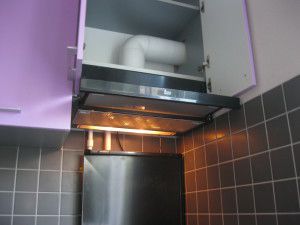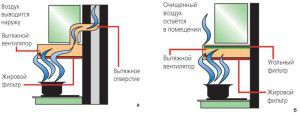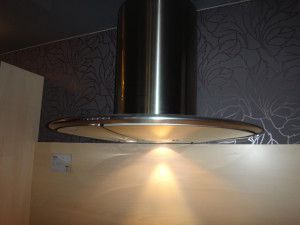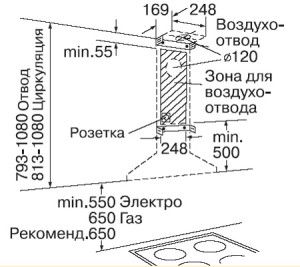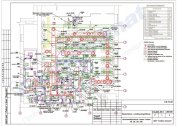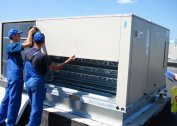The smell of food is good in the kitchen. The cozy living room smells of flowers, perfumes, but not fried potatoes. Cooker hoods can perfectly trap heat, steam, and children, or burn electricity for nothing.
All kitchen hoods are divided into two categories: with connection to the ventilation shaft and autonomous. Properly selected and correctly connected to the ventilation shaft hood will not disappoint the owners.
Types of cooker hoods
By installation, the following types of cooker hoods are distinguished:
- mounted (standard and flat) - are mounted under a shelf or wall cabinet above the stove;
- recessed - are built into the cabinet or specially constructed decorative box;
- wall mounted - hung directly on the wall, different design variety;
- angular - for installation in the corner of the kitchen;
- island - hung on the ceiling above the kitchen "island".
The functionality of ventilation hoods
Operating modes of hoods:
- Outflow. Cooker hood with venting the entire volume of exhaust air. It connects to the ventilation shaft or takes air into the street through a special hole in the wall. Hot moist air and unwanted aromas are removed from the apartment, providing a one hundred percent effect.
- Filtration. These are hoods without connection to ventilation. The air, filled with vapors and aromas of the kitchen, enters the filter and, purified, is sent back. Filters are placed inside the housing, periodically they need to be changed or washed.
Filtration or recirculation mode greatly simplifies installation. It is not necessary to decide how to remove the hood into the ventilation. In this case, the performance of the equipment is noticeably reduced.
Filtration of a kitchen hood with a tap is made by sintepon, coal, paper, non-woven, acrylic or metal filters.
Dense carbon filter reduces motor power.
The rules for installing the hood without venting to ventilation, as well as how to properly connect the hood to ventilation, read on.
Hood performance
This indicator primarily affects the quality of indoor air processing. Productivity determines the volume of air passed in 1 hour.
According to sanitary requirements in the kitchen, it is necessary to provide 12-fold air exchange.
We use the formula:
R x V x 12 x 1.3
Where R - area of the kitchen,1,3 - equalizing coefficient,12 - the multiplicity of air exchange,V - the height of the room.
Choose models with a power exceeding the calculated one by 10 - 15%.
Hood noise level
In modern homes, kitchens are adjacent to bedrooms and living rooms, so noise levels are very important. A constantly humming hood will cause headache and fatigue.
The more powerful the hood, the more noisy it works. But responsible manufacturers (for example, BOCSH, Siemens, Samsung) manage due to the special shape of the blades, the installation of twin fans and additional sound insulation to achieve quite quiet operation with impressive performance.
For reference, noise levels in different rooms, in decibels:
- in a quiet room - 30;
- the whisper of man - 35;
- the best hoods or quiet music - 40;
- human speech at a distance of 2.5 and noise of an average quality exhaust hood - 50.
Do not purchase a hood with a noise level above 50 decibels. She will bother the tenants of the apartment. The best hoods produce a noise of 44 decibels, and at maximum power no more than 70.
To minimize noise, models with an external motor have been developed. The engine is placed at the outlet of the duct. These are kitchen hoods connected to ventilation.
Additional options
Lighting. The vast majority of cooker hoods connected to ventilation and autonomous are supplied with this function. There are models with a change in the brightness of the light, focusing the beam. Equipped with a motion sensor turn on the light when the hostess approaches.
Touch control panel and display. Convenient, but you can do it. The display shows the operating mode, and the touch panel is much easier to keep clean than the protruding mechanical buttons or sliders (sliders).
Rules for installing the hood
Installation and connection of a kitchen hood to ventilation requires knowledge of a number of rules:
- the case is hung only on the level, with careful observance of the horizontal;
- the distance between the electric hob and the hood should be 65 cm;
- the distance between the gas hob and the hood - no more than 75 cm;
- the bend of the duct to connect the hood with ventilation does not exceed 90 degrees;
- when the duct length is more than 3 m, a second fan is installed to maintain traction;
- bringing the cooker hood into the ventilation, it is forbidden to block the ventilation vent in the wall;
- use pipes of the same cross section, since aerodynamic noise is amplified during narrowing;
- if the cooker hood is vented, it is advisable to install a valve to prevent back draft.
Before connecting a cooker hood to ventilation, you should read the instructions for it.
Connecting the hood to the ventilation riser
Before connecting the hood to the ventilation, take care of all the necessary accessories. To connect the hood for the kitchen with a tap into the ventilation, use corrugation or smooth round PVC ducts with elbows. The second option is preferable, as it creates less resistance to air, a smooth inner surface is easier to clean. The diameter of the pipe is not less than 120 mm; it is selected according to the exhaust outlet cross section. For mounting the duct, the hood is equipped with an adapter.
The air duct must have no more than 3 bends, otherwise the efficiency will significantly decrease.
Most often, in order to properly connect the hood to the ventilation, it is necessary to stretch the duct and tightly tighten the end of the duct in the ventilation duct.
The connection of the cooker hood with ventilation will not block the ventilation hole if a special grill is installed.
The capacity of the general house ventilation is from 110 to 140 cubic meters of air per hour. Extraction power can be 180 - 700 cubic meters per hour.
Before you bring the hood into the ventilation, consider the possibility of outputting the duct into a specially made hole in the wall. Otherwise, a working device may cause the vehicle to tip over. A phenomenon that is especially dangerous in homes with gas heaters, leading to carbon monoxide poisoning.
Ducts join tightly, and at the outlet they install a check valve and a mesh.
After the hood is vented, it is connected to the mains. A standard voltage of 220 - 240 V and a frequency of 50 Hz is required. Sometimes grounding is supplied to the outlet, eliminating the possibility of a short circuit.
The main task when installing the hood without connecting to ventilation is to correctly place and supply electricity.
An extractor hood in a kitchen with a vent to the ventilation can work effectively when the filter area is equal to or slightly larger than the cooking surface.
According to the rules, a test run of the hood is carried out immediately after it is connected to ventilation and the mains. And only after a successful first inclusion put on a protective casing.
A video on how to connect the hood to the common duct without disturbing the ventilation of the apartment:
